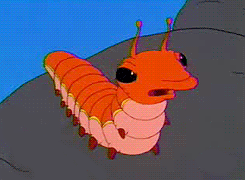Screamapillar
Screamapillar is a 7-note MODMOS in 17edo (or its close cousins like 27edt or 44ed6), or the temperament which characterizes this scale. Screamapillar has three different step sizes and is described as a LLmmLLs scale (i. e., 3322331). As such, it is not a maximally even scale (since seconds, thirds, sixths, and sevenths all come in three rather than two sizes). However, screamapillar is notable for being strictly proper, whereas the 17edo diatonic scale is not proper at all, and the 12edo diatonic scale is proper but not strictly so.
Screamapillar can be obtained by a single chromatic modification of the diatonic scale; if we take 17edo's diatonic major (Ionian) mode, and raise the fourth by one step, we get screamapillar (specifically, the Springfieldian mode). Screamapillar is also one modification away from the rast scale, so it has resemblance to both Western and Middle-Eastern scales. In fact, melodically, it corresponds to the bayati maqam.
Screamapillar is named by analogy with scorp (as both are arthropod creatures starting with "sc"), and also because the major fourth of 17edo (which functions as 11:8, among others) has a very bright sound as though it is "screaming"'; ambulance sirens often use similar intervals. Timbres where the eleventh harmonic is strong tend to take on a similar character.
The sharpened fourth could also be called a "red note" (opposite of a blue note) due to the mood it creates. Also, the Simpsons theme uses a scale which, although not exactly screamapillar, does contain a sharpened fourth.
Because screamapillar is so similar to the diatonic scale, it's not as xen as one might expect a no-fives 13-limit system to be, and as a result it makes a good starting point for someone who wants to explore these higher harmonies without sounding too foreign.
Screamapillar contains five types of tertian (root-third-fifth) triads. These include 2 supermajor, 2 subminor, 1 neutral, 1 neutral-diminished, and 1 subminor-diminished. Of these, the neutral triad is harmonically somewhat rough and so it might be a good idea to modify it, fortunately, there are several options for doing this, such as changing it to a sus2, sus4, or even sus4add2. On the other hand, the neutral-diminished triad is actually very nice sounding since it very closely approximates 9:11:13, and its fifth is still clearly a fifth (albeit a narrow one) rather than being ambiguous like the 12edo tritone.
The subminor and supermajor chords can be harmonically stabilized by adding, respectively, the 4th or the 2nd. This especially makes a difference in the latter case because supermajor triads sound somewhat unstable on their own.
Other high-limit chords and tone clusters can also be realized in screamapillar, including the approximations of 8:9:11:12 (which is like a sus chord but with more tension) and 12:13:14:16:18.
The modes of screamapillar could be given Simpsonsesque names as follows:
Springfieldian: Modified Ionian (major). 3 3 2 2 3 3 1
'Swartzwelderean': Modified Dorian. 3 2 2 3 3 1 3
Capitalcitian: Modified Phrygian: 2 2 3 3 1 3 3
Northhaverbrookian: Modified Lydian: 2 3 3 1 3 3 2
Shelbyvillean: Modified Mixolydian: 3 3 1 3 3 2 2
'Ogdenvillean': Modified Aeolian: 3 1 3 3 2 2 3
Spittlean: Moedified Locrian: 1 3 3 2 2 3 3
As a temperament
What is the temperament that provides the harmonic equivalencies featured in the screamapillar scale? Quite a few commas are tempered out including 64:63, 78:77, 99:98, 144:143, 243:242, etc.
While 17edo itself is an excellent choice for such a temperament, there are other options, notably 61edo, whose version of the screamapillar scale has step pattern 11 11 7 7 11 11 3. 78edo works as well (with step pattern 14 14 9 9 14 14 4); both of these improve the 7th and 13th harmonics at the expense of the 3rd and 11th.
Other options include 44edo and 27edo, although the latter is a borderline case because it doesn't have a very good 11 (it maps 11:8 to 577.78 cents).
